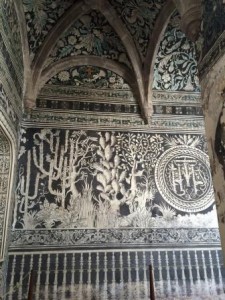sabbatical (n): a break from customary work to acquire new skills or knowledge, traditionally occurring every seventh year
Breaks Away: Sabbatical Stories of Hope
Each academic year, a number of Hope faculty take sabbatical leaves away from the college, submersing themselves for extended periods of time into their favored fields of inquiry. If viewed from above and all together, those fields would look like a calico landscape, so varied and colorful is the topography of their collective research, writing, and creative pursuits. Offering restoration and adventure both, sabbaticals are a bit like information and imagination transfusions. These breaks away from normal classroom and committee work give Hope academicians a boost to reinforce and revitalize their teaching and scholarship.

Dr. Renata Fernandez’s return to her native country for sabbatical last spring had more to do with churchgoing than homecoming. For it was on the walls of numerous Catholic churches and former convents and monasteries in Mexico that Dr. Fernandez focused much of her research into the “camouflaged culture of resistance” rendered by indigenous artisans in the mid-1500s.
“I am captivated by the first generation of colonial evangelism in Mexico. So I had to go back to dig into the material culture there,” explains Dr. Fernandez, who is originally from Veracruz and travelled to more than 10 rural towns in five different Mexican states for her research.
What she discovered were the muted underpinnings of early native resistance. In those many Dominican, Franciscan and Augustinian churches and convents she visited, tucked in murals or hiding in plain sight in sculptures, are symbols that subtly defy the friars’ artistic and evangelistic orders. Instructed to duplicate European patterns and designs from books brought by the Spaniards, the local artists complied, but only to a point. Instead, they shrewdly incorporated local animals, plants, and deities alongside Renaissance decorative motifs.
“These artists were saying, ‘This is my sacred space as much as it is yours. Yes, I will praise your God, but in reality, I’ll retain my own too. We will remember our history even though you want us to forget it.’” — Dr. Renata Fernandez
These works of art depict then the tension that resulted from a clash of cultures, especially one that had been aggressively overtaken. The cleverly appropriated art was not an overt, orchestrated rebellion, but it was the beginning of clever opposition that would eventually lead to one.
Dr. Fernandez explains that “these artists were saying, ‘This is my sacred space as much as it is yours. Yes, I will praise your God, but in reality, I’ll retain my own too. We will remember our history even though you want us to forget it.’”

Interestingly, Dr. Fernandez also found that the use of covert indigenous symbols were especially prominent in Augustinian structures. Another question she’s asking then, and will further research to find the answer, is “Were the Augustinian monks oblivious to what was happening on their walls, or did they allow the native renderings to make evangelization easier?”
“I’m also wondering, is there a pattern? Does this kind of resistance happen in other Spanish territories, such as Peru?”
So, Dr. Fernandez has more work to do but she has a voluminous start. For now, she will use many of her new findings in her upper-level Spanish course on Colonial Latin American literature and culture at Hope. She also plans to write a text for “there is currently not one book that teaches what I want to teach.” She hopes to fill this textbook void by unapologetically taking on the domination discourse of Mexican conquest and unveiling a sophisticated pre-colonial society determined to retain and never forget its cultural and symbolic origins. Like the frescoes and sculptures that soared before her in Mexico, she has a story to tell. And this time it won’t be that subtle.
—
Dr. Renata Fernadez is an associate professor of Spanish in the Modern and Classical Languages Department at Hope College.

